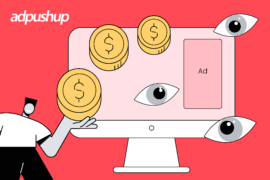Learn all about ad revenue optimisation and website monetisation for publishers in 2022-23
Publishers are seeing a sharp decline in their display ad revenue caused due to ad blockers. There’s a growing need for them to find other money-generating sources in order to to monetise website and offset all of the revenue losses.
So while you’re probably exploring all kinds of options to generate additional revenue, I’m going to give you some actionable organic traffic-growing tips you may not know about; also some other useful publisher’s hacks on website monetization to help you get equipped.
First, let’s take a look at the trends from last year.
Analysing Trends From 2022
There were some interesting trends we saw in 2022 which’ll continue in 2023. Here’s the essence of them:
Facebook Video Monetization
This option has been around for quite some time now. There has been a lot of testing conducted for ad breaks during live broadcasting and on-demand videos (VOD). Owing to that, Facebook is now creating new money-making opportunities to content creators to monetize their websites.
This trend will keep growing due to the fact that video content accounted for 80% of online traffic in 2022. The other growing trend is about ad impressions being more and more served on addressable TV and IPTV. Hence it’s a new chance for broadcasters to monetize their inventory through video on the growing CTV market.
Initial Free Content
Websites with valuable content can quickly gain popularity. Consequently, many publishers started rolling the dice by offering free content as one of their website monetization hacks in hopes of short-term growth. However, for app publishers, this can’t be a sustainable approach to monetize website as many applications are already functioning for free in order to gain traffic.
On that note, if your content is a gold mine that has the potential to drive lots of traffic, consider the freemium model (for gaming app) or partially closed content (for news portals). The intent is to always give your fans a room for development and a chance to purchase more if they like your content.
Revamped Paywall
Back in old days, the best website monetization strategy was exclusivity, and many publishers used to block off their content with a paywall. This doesn’t really work today as there are alternative sources which provide the similar information.
Customers are simply able to find a free version, unless it’s not a full-scale research, a survey, or a long-read with statistics/interviews from industry experts.
To make it work, you can apply a timed paywall on the rest of your content一customers will be allowed to access the digital content for a limited time; though afterwards, they’ll be required to make a purchase to continue.
Affiliate links: What Works, And How
This can be an awesome money-driving, website monetization strategy, if executed correctly. Many e-commerce sites run affiliate programs where they offer referral rewards to users in return for promoting their sales via their site.
The essence of this strategy is to provide value to users by offering detailed reviews of the products. These can be found on an e-commerce partner’s site with a link that accompanies it and gives credit to the affiliate for all sales.
Similarly, affiliate links prove beneficial for both publishers and advertisers. The more sites you have, the more customers you’ll attract for advertisers using your content. Eventually, you’ll be able to obtain more money from your website or a non-commercial yet interesting blog.
Understanding Trends for 2022 And Tips For Publishers
We decided to make emphasis on affiliate marketing in 2021 and 2022 years alike. It’s not a coincidence, since it gives a fairly quick start for the business. Publishers can do nearly everything in one day (from registration to advertising to sale) and receive from upto 2 to 50% commission from every sale occuring on their website through the advertiser’s link.
So having said that, affiliate marketing is still the #1 website monetization option for advertisers. However in 2022, it might have to compete with these new emerging website monetization trends:
Influencer Marketing
According to a study by Twitter, 49% of Twitter users rely on reviews from influencers before making a purchase. 40% of those surveyed said they even bought something just because an influencer tweeted about it.
Likewise, custom affiliate links are great if your goal is to increase number of leads coming from your most popular source. Also, if you have just the right blend of affiliate and influencer marketing together.
Voice Search Content Optimization
With all the voice-activated searches in smartphones and smartwatches nowadays, as an affiliate marketer, you simply cannot ignore this factor impacting your SEO efforts.
It’s also important because, according to ComScore, 60% of all search queries will be voice activated by 2022 making it a trend that’s here to stay. Hence, if a user asks a question, the likelihood of it to be a voice search is quite high.
Although the problem here is the same as the one with influencer marketing一how much do you think consumers trust Google and it’s answers. For example, you make a voice search asking “Which is the best restaurant in Portland?” and you get certain results.
Though it’s possible you’ll probably know that this is not necessarily the best restaurant in Portland. This restaurant just happens to invest a lot of money on their SEO efforts.
Native Advertising: The Inside Story
Native advertising digital format qualified for 71% of ad spend in US by the end of 2022, replacing regular banner ads from its pedestal.
To the users, native ad units seem a part of the content on a website, so it doesn’t interfere with their online experience. Hence, the ad delivers better performance. Business Insider predicts brands will spend as much as $28,9 billion on native advertisements for website monetization in 2022.
For advertisers, it’s really difficult to target native ads without analytics tools as they might never know who their customers are. Channeling native ads through programmatic software can be a real way out, as it offers outstanding targeting options for advertisers.
Many advertisers inside the programmatic chain are offering highest bids for the inventory which meets their campaign demands. The relevance of inventory to the ad is determined during the real-time auction that connects supply platform (SSP for publishers) and demand platform (DSP for advertisers).
Ad Networks: What They Mean For Publishers
An ad network is fundamentally different from alternative media advertising networks because it deploys an ad server. The ad server delivers the ads to the users. It allows to target, track, and generate reports for each ad unit display.
Big publishers use ad networks to sell their remnant inventory, the volume of which varies anywhere between 10 and 60% of their total inventory. Though the common problem of an ad network is poor performance of Internet advertising.
Frequently, it is caused by the lack of control over inventory or ad unit quality. That’s why, the ‘vertical’ ad network will replace ‘horizontal’ ones any time soon. Vertical ad networks are more transparent and provide all the necessary information about ad placements.
Such networks deliver ads only to specific audiences and contribute to traffic quality improvement along with price adequacy.
The Afterword
It can be difficult for publishers to navigate their way around numerous website monetization options. But it’s worthwhile to remember, no one said you should be limited to a single one.
One thing’s for sure一different website monetization options will provide you with different results in terms of performance: yield, audience engagement, conversion, and so on.
However, the combination of those options can bring out just the right synergy which’ll help you achieve the website performance goals you strive for.
—
This post is authored by Ivan Guzenko, CEO of SmartyAds, a programmatic advertising company. He is a block-chain enthusiast and actively consults startups on adoption of latest advertising techniques.

Shubham is a digital marketer with rich experience working in the advertisement technology industry. He has vast experience in the programmatic industry, driving business strategy and scaling functions including but not limited to growth and marketing, Operations, process optimization, and Sales.







